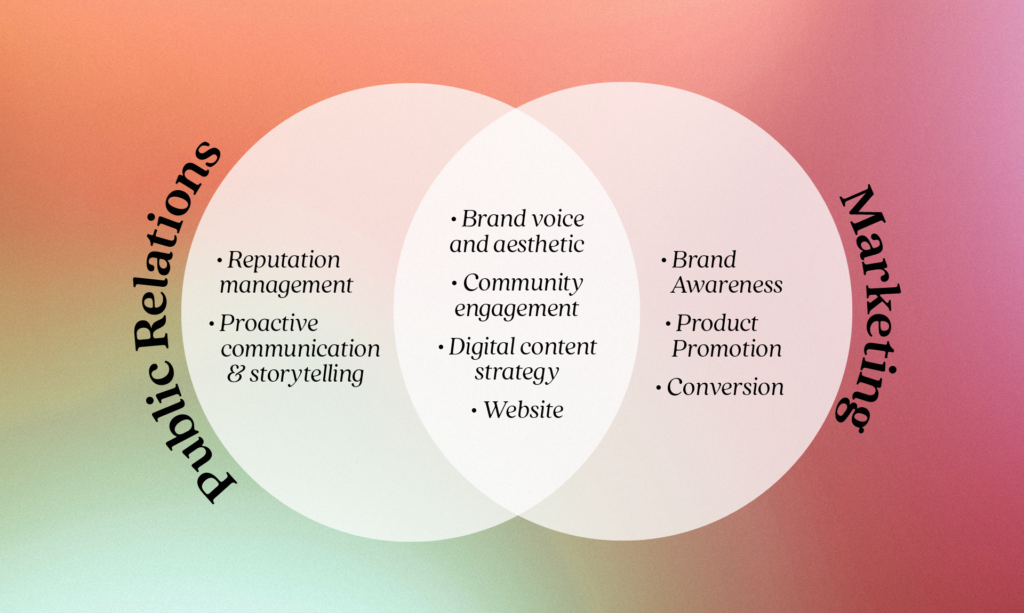
Why you need both PR and marketing to build brand awareness
Multi-channel campaigns are 37% more effective than single-channel campaigns because they allow for multiple customer touch points. That powerful and positive “word-of-mouth” reputation so many organizations strive for? It’s often the result of an integrated marketing effort that includes PR.
The Public Relations Society of America (PRSA) defines public relations as “a strategic communication process that builds mutually beneficial relationships between organizations and their publics.” If you’re thinking, “okay, great, but how do we actually do that?” Welcome — you’re in the right place.
When thinking PR, are you imagining Samantha Jones sipping a cosmo à la Sex and the City or a massive corporation covering up a misdoing? Or, are you picturing something like this:
- Write press release
- Send press release to media
- Hope the media cover your news
In reality, PR is so much more than that (sigh of relief). Modern PR, while still built around media relations, has evolved into uncovering natural storylines, weaving those stories throughout your brand and messaging, and then strategically sharing them via media and grassroots relationships.
In addition to media relations, your PR plan could include the following tactics:
- Creating thought leadership content
- Speaking opportunities
- Sponsoring or participating in an event that aligns with your brand mission
- Developing super creative campaigns that don’t fit into any kind of box — an event or program that doesn’t exist yet, but should
- Deepening giveback initiatives
- Strengthening overall community engagement
- Incorporating DE&I initiatives into your organization
If you’re thinking, “this sounds like something our organization should be doing,” you’re absolutely correct. We all know it’s better to be proactive than reactive — the same goes for telling your brand’s story.
So, how do you determine if an effort is worthy of a PR campaign? Start by asking yourself a few questions:
- Is it timely or culturally relevant?
- Is there a connection to a greater initiative?
- Does it feature a prominent community member or organization?
- Who is benefiting?
- Is this a new development or launch?
- Is there an audience for this message?
If you’re coming up short answering these questions, well, that in itself is your answer — there’s probably a more appropriate promotional method. If you can confidently answer “yes” or expand on three or more questions, chances are you have pretty solid ground for a PR campaign.
Want to really make magic? Integrate your PR with your marketing efforts.
PR can also only succeed if you present a consistent message across channels. If you put out a press release about a new program you launched, but don’t surround it with a website experience or social media posts to back it up, you’ve thwarted the potential of your PR effort, or worse — eroded brand trust. Stoltz believes in marketing and PR as the ultimate brand awareness dream team.

PR
Reputation management
Proactive communication and storytelling
Middle
Brand voice and aesthetic
Community engagement
Digital content strategy
Website
Marketing
Brand Awareness
Product Promotion
Conversion
Let’s talk about success measurement. Ultimately, media placement for your product launch, giveback effort, or thought piece penned by a company leader is a solid benchmark. But there are other measurements of success that are important to consider:
- Did a top or target publication cover your story?
- What were overall impressions?
- Was your story shared organically on social media?
- Did you see an increase in followers or engagement on your social media channels?
- Was there an increase in overall web traffic or to key pages related to your story?
- What was the nature or sentiment of the coverage?
- Were there incredible pull quotes?
- Did the product you announce sell out?
Together, we can define goals and measures of success that are unique to your organization.
If you’re curious how PR might help you achieve your marketing and business goals, let’s chat. Send an email to [email protected] to get started.
If you’re looking to learn more, here are some of our favorite resources to help you maneuver the big world of PR.
Podcasts:
People/pages to follow:




